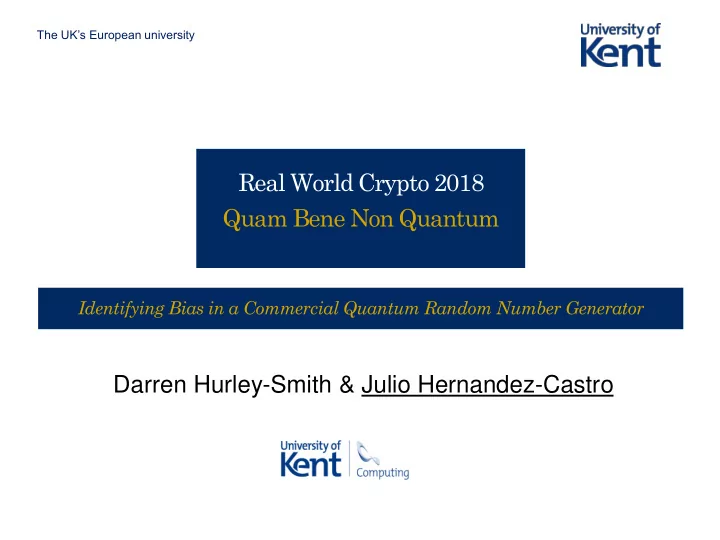

The UK’s European university Real World Crypto 2018 Quam Bene Non Quantum Identifying Bias in a Commercial Quantum Random Number Generator Darren Hurley-Smith & Julio Hernandez-Castro
Index Introduction Related works Aims Experimental settings Results Conclusions Future works Q&A Page 2 Quam Bene Non Quantum: Identifying Bias in a Commercial Quantum Random Number Generator
Our targets Page 3 Quam Bene Non Quantum: Identifying Bias in a Commercial Quantum Random Number Generator
Our targets (continued) Three modules tested: All three use Optical Quantum phenomena as their entropy source (beam splitting) 16M (PCI-E 16Mb/s) @ € 2990 4M (PCI-E 4Mb/s) @ € 1299 USB (4Mb/s) @ € 990 Data Collection: 100 x 2GiB collected from each device EasyQuantis command-line utility Raw and post-processed data Speedtest Results (Raw) 16M (15.87Mb/s), 4M (3.86Mb/s), USB (3.96Mb/s) ChaosKey TRNG (3.8Mb/s) @ € 59 Page 4 Quam Bene Non Quantum: Identifying Bias in a Commercial Quantum Random Number Generator
Results (in a nutshell) Quantis Claims Our Results True random bits No. Heavily biased and correlated No. Roughly 1/4 th of that after post- 16Mb/s, 4Mb/s of true random bits processing Post-processing optional No. Vital & costly Self-certification is OK Self-certification is worthless Third party certification is OK Certification (below CC EAL5 or AIS 31 PTG.3) is useless TRNGs with closed hardware No. design are OK Security by obscurity and all that Page 5 Quam Bene Non Quantum: Identifying Bias in a Commercial Quantum Random Number Generator
Detailed Results (Dieharder/NIST/TestU01) Device Size Dieharder NIST STS 2.1.2 Alphabits Rabbit (GiB) (Failed/Weak/Passed) (Passed/Total) (Passed/Total) (Passed/Total) Quantis 16M 2 8 / 11 / 95 182 / 186 7 / 17 26 / 40 2 6 / 13 / 95 181 / 186 9 / 17 32 / 40 2 7 / 11 / 96 182 / 186 7 / 17 29 / 40 Quantis 4M 2 0 / 3 / 111 185 / 186 7 / 17 28 / 40 2 0 / 5 / 109 186 / 186 7 / 17 28 / 40 2 0 / 6 / 108 186 / 186 7 / 17 27 / 40 Quantis USB 2 0 / 6 / 108 184 / 186 14 / 17 33 / 40 2 0 / 7 / 107 186 / 186 11 / 17 29 / 40 2 1 / 6 / 107 184 / 186 10 / 17 30 / 40 ChaosKey 2 0 / 3 / 111 184 / 186 17 / 17 40 / 40 2 0 / 3 / 111 186 / 186 17 / 17 40 / 40 /dev/urandom Dieharder and NIST are passed 16M is an exception, but further testing suggests these three initial results are anomalous Alphabits and Rabbit fail consistently Devices fail slightly different tests more frequently than others ChaosKey (TRNG USB module) passes all tests providing a TRNG baseline urandom also passes all tests providing a PRNG baseline Page 6 Quam Bene Non Quantum: Identifying Bias in a Commercial Quantum Random Number Generator
We’ve seen bad X 2 Results before … DESFire EV1 bias EV1 Fourier Analysis Quantis 16M bias Quantis 4M bias Quantis USB bias /dev/random bias Page 8 Quam Bene Non Quantum: Identifying Bias in a Commercial Quantum Random Number Generator
Conclusion Many TRNGs seem to barely pass well-known tests, then fail new ones Perhaps the classical test are all measuring the same things Perhaps an example of lazy engineering They are designed-for-testing Quantum random number generation Inherent bias due to thermal noise on optical QRNG is a known phenomenon – physics circles Many devices claim random output despite this Randomness is achievable, but requires supporting hardware/software Post-processing should be accounted for One shouldn’t claim robust randomness at speeds prior to post -processing Post-processing is NOT optional Potential attack surface increases Manipulation/poor choosing of the input matrix can affect output predictably Unsuitable for IoT devices Page 9 Quam Bene Non Quantum: Identifying Bias in a Commercial Quantum Random Number Generator
Future Works: More Quantum TRNGs Hotbits @ https://www.fourmilab.ch/hotbits/ Timed successive pairs of radio-active decay events as entropy source Performs poorly in all tests except NIST STS 2.1.2 Australian National University (ANU) QRNG @ https://qrng.anu.edu.au Broadband measurement of a vacuum field contained in the radio frequency sidebands of a single-mode laser Performs well in most tests - Some issues with TestU01 Rabbit Humboldt University Physik Generator @ https://qrng.physik.hu-berlin.de Quantum randomness of photon arrival times as entropy source Performs very well in all tests so far Dieharder, NIST STS 2.1.2, TestU01, Ent, all report good results Comscire PQ32MU @ https://comscire.com/product/pq32mu/ Quantum Entropy provided by shot-noise due to sub-threshold and gate tunnelling leakage in MOS transistors Performs well in all tests Extremely high rate of number generation (32Mb/s) Built-in post-processing Bulky! Page 10 Quam Bene Non Quantum: Identifying Bias in a Commercial Quantum Random Number Generator
Acknowledgements This work received funding from the European Union’s Horizon 2020 research and innovation programme, under grant agreement No.700326 (RAMSES project). We would like to thank ECOST – CRYPTACUS action for their valuable and insightful discussion of this work We would like to convey our thanks to ID Quantique (IDQ) for their timely and professional response to our responsible disclosure Page 11 Quam Bene Non Quantum: Identifying Bias in a Commercial Quantum Random Number Generator
Thank you for listening Questions? Page 12 Quam Bene Non Quantum: Identifying Bias in a Commercial Quantum Random Number Generator
Recommend
More recommend